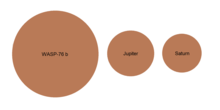WASP-76
WASP-76, also known as BD+01 316, is a yellow-white main sequence star in the constellation of Pisces. Since 2014, it has had one suspected stellar companion at a projected separation of 85 astronomical units.[5][6]
| Observation data Epoch J2000 Equinox | |
|---|---|
| Constellation | Pisces |
| Right ascension | 01h 46m 31.8577s[1] |
| Declination | 02° 42′ 02.0332″[1] |
| Apparent magnitude (V) | 9.52[2] |
| Characteristics | |
| Evolutionary stage | main sequence star |
| Spectral type | F7V |
| B−V color index | 0.61 |
| J−H color index | 0.21 |
| J−K color index | 0.3 |
| Astrometry | |
| Radial velocity (Rv) | −1.152±0.0033[3] km/s |
| Proper motion (μ) | RA: 45.398[1] mas/yr Dec.: -40.819[1] mas/yr |
| Parallax (π) | 5.1204 ± 0.1579[1] mas |
| Distance | 640 ± 20 ly (195 ± 6 pc) |
| Details | |
| Mass | 1.46±0.07 M☉ |
| Radius | 1.73±0.04 R☉ |
| Surface gravity (log g) | 4.4±0.1[4] cgs |
| Temperature | 6250±100 K |
| Metallicity [Fe/H] | 0.23±0.1 dex |
| Rotational velocity (v sin i) | 3.3±0.6[4] km/s |
| Age | 5.3+6.1 −2.9[4] Gyr |
| Other designations | |
WASP-76, 2MASS J01463185+0242019, Gaia DR2 2512326349403275520 | |
| Database references | |
| SIMBAD | data |
Planetary system
The "hot Jupiter" class planet WASP-76b was discovered around WASP-76 in 2013.
| Companion (in order from star) |
Mass | Semimajor axis (AU) |
Orbital period (days) |
Eccentricity | Inclination | Radius |
|---|---|---|---|---|---|---|
| b | 0.92±0.03 MJ | 0.033 | 1.809886±0.000001 | 0 | 88.0±1.6° | 1.83±0.06 RJ |
gollark: Oh, if you want to avoid JS, check out this useful HTML feature: https://developer.mozilla.org/en-US/docs/Web/HTML/Element/details
gollark: Plus, I do very aggressive caching.
gollark: My static site's faster than a dynamic one and can run on a server without much configuration.
gollark: ...
gollark: Well, I would recommend using a static site generator of some kind.
References
- Brown, A. G. A.; et al. (Gaia collaboration) (August 2018). "Gaia Data Release 2: Summary of the contents and survey properties". Astronomy & Astrophysics. 616. A1. arXiv:1804.09365. Bibcode:2018A&A...616A...1G. doi:10.1051/0004-6361/201833051. Gaia DR2 record for this source at VizieR.
- Høg, E.; et al. (2000). "The Tycho-2 catalogue of the 2.5 million brightest stars". Astronomy and Astrophysics. 355: L27–L30. Bibcode:2000A&A...355L..27H.
- Soubiran, C.; Jasniewicz, G.; Chemin, L.; Zurbach, C.; Brouillet, N.; Panuzzo, P.; Sartoretti, P.; Katz, D.; Le Campion, J. -F.; Marchal, O.; Hestroffer, D.; Thévenin, F.; Crifo, F.; Udry, S.; Cropper, M.; Seabroke, G.; Viala, Y.; Benson, K.; Blomme, R.; Jean-Antoine, A.; Huckle, H.; Smith, M.; Baker, S. G.; Damerdji, Y.; Dolding, C.; Frémat, Y.; Gosset, E.; Guerrier, A.; Guy, L. P.; et al. (2018). "Gaia Data Release 2. The catalogue of radial velocity standard stars". Astronomy and Astrophysics. 616: A7. arXiv:1804.09370. Bibcode:2018A&A...616A...7S. doi:10.1051/0004-6361/201832795.
- Three irradiated and bloated hot Jupiters: WASP-76b, WASP-82b, and WASP-90b
- Ngo, Henry; Knutson, Heather A.; Hinkley, Sasha; Bryan, Marta; Crepp, Justin R.; Batygin, Konstantin; Crossfield, Ian; Hansen, Brad; Howard, Andrew W.; Johnson, John A.; Mawet, Dimitri; Morton, Timothy D.; Muirhead, Philip S.; Wang, Ji (2016). "FRIENDS OF HOT JUPITERS. IV. STELLAR COMPANIONS BEYOND 50 au MIGHT FACILITATE GIANT PLANET FORMATION, BUT MOST ARE UNLIKELY TO CAUSE KOZAI–LIDOV MIGRATION". The Astrophysical Journal. 827 (1): 8. arXiv:1606.07102. Bibcode:2016ApJ...827....8N. doi:10.3847/0004-637X/827/1/8.
- Ginski, C.; Mugrauer, M.; Seeliger, M.; Buder, S.; Errmann, R.; Avenhaus, H.; Mouillet, D.; Maire, A.-L.; Raetz, S. (2016). "A lucky imaging multiplicity study of exoplanet host stars – II". Monthly Notices of the Royal Astronomical Society. 457 (2): 2173–2191. arXiv:1601.01524. Bibcode:2016MNRAS.457.2173G. doi:10.1093/mnras/stw049.
- Planet WASP-76 b at exoplanet.eu
External links
This article is issued from Wikipedia. The text is licensed under Creative Commons - Attribution - Sharealike. Additional terms may apply for the media files.
